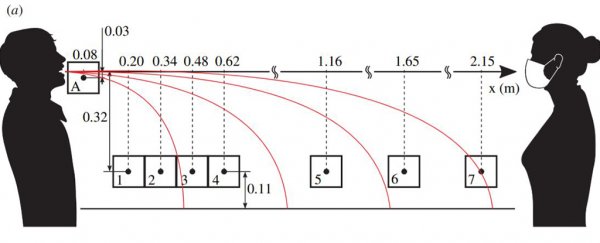Getting coughed on has never been a pleasant experience, but 2020 has made it a whole new level of nope.
Even with vaccines being rolled out, our main lines of defence against COVID-19 are still physical, with distancing from each other and wearing a mask being chief amongst them.
Unfortunately, there's still resistance in some circles to both of these measures. And even if you're completely on board, sometimes it can be easy to forget.
So, prepare to be grossed out. Engineers at the University of Edinburgh in the UK have done a study on masks and how effectively they stop large respiratory droplets at various distances.
It's important to get rid of some misconceptions straight up. SARS-CoV-2 virus particles are way smaller than the holes in the fabric of a mask - but the virus particles don't exist in isolation.
When you cough, talk, or even breathe, tiny globs of your spit fly out of your mouth and land on whatever is in front of you, and it's those globs that can carry the virus.
Now, there's still some debate about whether smaller aerosol particles are also a significant driver of infection, but a mask is pretty good at stopping them, too.
When it comes to catching the virus (and pretty much all viruses), making sure you are exposed to as few of those virus particles as possible is key, so the fewer droplets - small or large - you encounter, the better.
The team compared how many of the larger spit globs landed on surfaces from various distances whilst a person was wearing a mask versus remaining mask-less.
The results are both astonishing and gross.
"Wearing a face covering decreased the number of projected droplets by less than 1,000-fold," the team, led by bioengineer Lucia Bandiera, writes in the study.
"We estimated that a person standing 2 metres [6.6 feet] from someone coughing without a mask is exposed to over 1,000 times more respiratory droplets than from someone standing 0.5 metres [1.6 feet] away wearing a basic single layer mask."
The team investigated this in a number of ways. A manikin head that shot out fluorescent drops of water in speech and cough simulations was observed with laser sheet illumination and UV light.
They also had six human volunteers, whose spittle was caught on a microscope slide 5 centimetres (2 inches) from their mouths.
 (Bandiera et al., Royal Society Open Science, 2020)
(Bandiera et al., Royal Society Open Science, 2020)
As you can see in the figure above, the masks made a real difference in the spread of these larger drops of spit. In fact, in every single test, the number of droplets plummeted while a mask (either single-layer cotton, or surgical) was worn.
"When the manikin wore any of the two face masks, we observed that less than one in 1,000 particles escaped for both speaking and coughing," the team writes.
When they tested the six human volunteers to confirm, the results were just as good.
"We measured between 10s and 1,000s of particles for speaking and coughing without a mask, respectively. Conversely, we found zero particles with the surgical mask, both for speaking and coughing."
Obviously, this is not the final say on this topic, nor does it make masks perfectly foolproof. The study didn't look at the smaller aerosol droplets, and the manikin ejected particles for a lot longer than a human would - 60,000 coughs to be exact.
But it's a great reminder that even a simple homemade mask can be incredibly effective at limiting your spit globs getting everywhere, which can make a difference to reducing the spread of COVID-19. We are all in this together.
The research has been published in Royal Society Open Science.
